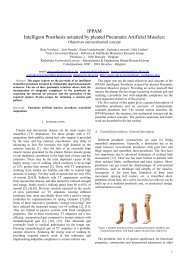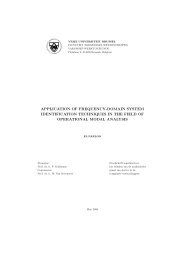VRIJE UNIVERSITEIT BRUSSEL Acoustics - the Dept. of ...
VRIJE UNIVERSITEIT BRUSSEL Acoustics - the Dept. of ...
VRIJE UNIVERSITEIT BRUSSEL Acoustics - the Dept. of ...
Create successful ePaper yourself
Turn your PDF publications into a flip-book with our unique Google optimized e-Paper software.
94 CHAPTER 5. SOUND INSULATIONk = 2×1.4P 0D(5.31)The resonance frequency is equal to :f 0 = 1√k2π m = 1√ √2.8P0 12π mD ≈ 84 mD(5.32)If <strong>the</strong> sound has a frequency equal to f 0 both walls will resonate andthus transmit <strong>the</strong> sound. For common used double glazing <strong>the</strong> insulationat low frequencies (100-300 Hz) will <strong>the</strong>refore be low (doubleglazing with m = 10 kg/m 2 and a air layer thickness <strong>of</strong> 1 cm we foundf 0 = 266 Hz).7. The air layer between <strong>the</strong> walls has also an infinite range <strong>of</strong> eigenfrequenciesat which <strong>the</strong> system becomes transmissive for sound. Thefundamental frequency is found by taking <strong>the</strong> distance d as half <strong>of</strong> <strong>the</strong>wavelength :f 1 = c λ = c(5.33)2dThe harmonics are integer multiples : f 2 = 2f 1 , f 3 = 3f 1 , ... .These frequencies are usually high. One can damp all those resonancesby applying absorbing materials between <strong>the</strong> two panels, if possible.8. Each panel has its own critical coincidence frequency. It is preferredto select <strong>the</strong> thickness <strong>of</strong> both panels different such that <strong>the</strong> criticalfrequencies do not coincide.5.2.5 Insulation <strong>of</strong> a composite wallConsider a wall with total surface S composed <strong>of</strong> different materials (e.g.windows, doors, walls, etc.) In <strong>the</strong> following we will calculate <strong>the</strong> insulationvalue <strong>of</strong> composite walls. Suppose that <strong>the</strong> wall with surface S consists <strong>of</strong>two components with surfaces S 1 and S 2 and that <strong>the</strong>se components have adifferent insulation value :R 1 = L z −L 1 +10log S 1AR 2 = L z −L 2 +10log S 2A
















